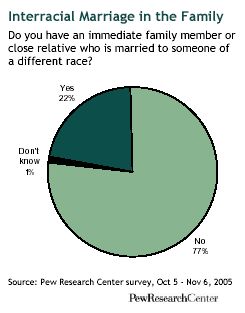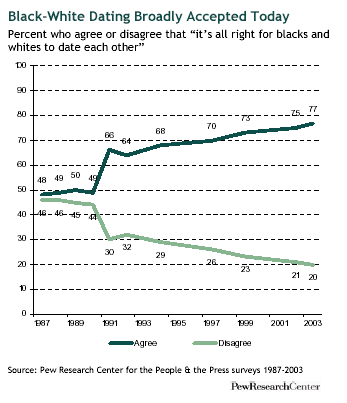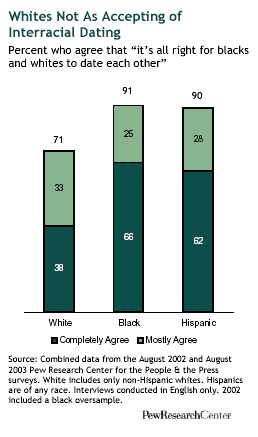 More than one-fifth of all American adults (22%) say that they have a close relative who is married to someone of a different race, according to a new Pew Research Center survey.
More than one-fifth of all American adults (22%) say that they have a close relative who is married to someone of a different race, according to a new Pew Research Center survey.
That degree of familiarity with — and proximity to — interracial marriage is the latest milestone in what has been a sweeping change in behaviors and attitudes concerning interracial relationships over the past several decades.
Until 1967, when a U.S. Supreme Court ruling in Loving v. Virginia struck down the last of the anti-miscegenation laws in this country, interracial marriage had been illegal in 16 states and was widely considered a social taboo.
Since then interracial marriage in this country has evolved from nearly non-existent to merely atypical. In 1970, fewer than one percent of all married couples were made up of spouses of a different race; by 2000 that figure had grown to just over 5%, according to an analysis of U.S. Census Bureau data by the Population Reference Bureau, a nonpartisan research organization.1
 At the same time, attitudes toward interracial relationships have also grown more tolerant. In 2003, more than three-quarters of all adults (77%) said it is “all right for blacks and whites to date each other,” up from 48% who felt this way in 1987, according to Pew Research Center surveys.
At the same time, attitudes toward interracial relationships have also grown more tolerant. In 2003, more than three-quarters of all adults (77%) said it is “all right for blacks and whites to date each other,” up from 48% who felt this way in 1987, according to Pew Research Center surveys.
Acceptance of interracial dating is greatest among the young. In surveys conducted in 2002 and 2003, fully 91% of Gen Y respondents born after 1976 said that interracial dating is acceptable, compared with 50% of the oldest generation (those reaching adulthood during WWII) who expressed this view.
Also, blacks (91%) and Hispanics (90%) are more accepting of interracial dating than are non-Hispanic whites (71%).
 In the new Pew survey, conducted from Oct. 5 through Nov. 6, 2005 among a randomly-selected, nationally-representative sample of 3,014 adults, there are also differences by race in family experiences with interracial marriage.
In the new Pew survey, conducted from Oct. 5 through Nov. 6, 2005 among a randomly-selected, nationally-representative sample of 3,014 adults, there are also differences by race in family experiences with interracial marriage.
Blacks (37%) are twice as likely as whites (17%) to have an immediate family member in an interracial marriage, while Hispanics (27%) fall in the middle of those two groups. (There were not enough Asians in the national sample to permit any meaningful analysis of this population sub-group).
There is also a variance by age in reports of interracial marriage in the family. More than one third (34%) of all 18 to 29 year olds say they have a family member or close relative who is married to someone of a difference race, compared with 14% of those ages 65 and older who say this.
 The survey finds no correlation with income or with education in the likelihood of having a family member in an interracial marriage, but there is a slight regional pattern in the reporting of mixed race marriages in the family. More westerners (28%) say they have a close relative in an interracial marriage than do those who live in the south (22%), the northeast (19%), or the midwest (19%).
The survey finds no correlation with income or with education in the likelihood of having a family member in an interracial marriage, but there is a slight regional pattern in the reporting of mixed race marriages in the family. More westerners (28%) say they have a close relative in an interracial marriage than do those who live in the south (22%), the northeast (19%), or the midwest (19%).
This regional tilt toward the west is likely explained, at least in part, by the relatively higher percentage of Asian-Americans, American Indians and multi-race Americans who live in western states compared with the rest of the country. Members of all those groups are more likely to marry outside their race than are whites, blacks or Hispanics, according to the Population Bureau analysis of Census data.
According to Census data, the most common type of interracial couple in 2000 was a white husband married to an Asian wife; this pairing comprised 14 percent of all interracial couples. Black husbands and white wives accounted for 8 percent of all interracial couples. The Census data also show that in 2000 73% of all black-white married couples the husband is black, while in 75% of all Asian-white couples, the husband is white.
Read the full report for more details.


